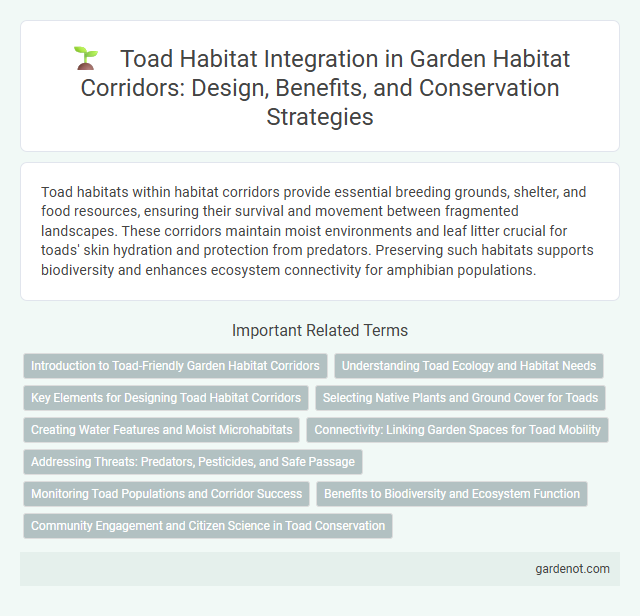Toad habitats within habitat corridors provide essential breeding grounds, shelter, and food resources, ensuring their survival and movement between fragmented landscapes. These corridors maintain moist environments and leaf litter crucial for toads' skin hydration and protection from predators. Preserving such habitats supports biodiversity and enhances ecosystem connectivity for amphibian populations.
Introduction to Toad-Friendly Garden Habitat Corridors
Toad-friendly garden habitat corridors create safe passageways connecting fragmented environments, promoting amphibian movement and genetic diversity. These corridors incorporate moisture-rich soil, native plants, and shelter areas like logs or rock piles to support toad breeding and feeding. Designing such habitats reduces road mortality and encourages population stability within urban and suburban landscapes.
Understanding Toad Ecology and Habitat Needs
Toads thrive in moist, shaded environments such as wetlands, forest floors, and grasslands with abundant leaf litter and loose soil for burrowing. Their ecology depends on access to clean breeding ponds for reproduction and terrestrial habitats that provide shelter, food sources like insects, and safe overwintering sites. Effective habitat corridors connect these critical aquatic and terrestrial zones, facilitating safe movement and genetic exchange between toad populations.
Key Elements for Designing Toad Habitat Corridors
Effective toad habitat corridors incorporate moist, shaded environments with abundant leaf litter and diverse ground vegetation to support breeding and foraging. Connectivity between breeding ponds and terrestrial habitats is essential, ensuring safe passage across roads and fragmented landscapes through underpasses or culverts. Maintaining water quality and minimizing pesticide exposure within corridors enhance toad survival and reproductive success.
Selecting Native Plants and Ground Cover for Toads
Selecting native plants and ground cover such as ferns, sedges, and low-growing grasses creates ideal microhabitats for toads by providing moisture retention, shelter, and abundant insect prey. Incorporating leaf litter and woody debris enhances ground cover complexity, supporting toad breeding and foraging activities within habitat corridors. Native plant diversity boosts ecosystem stability, promoting sustainable toad populations and facilitating safe movement across fragmented landscapes.
Creating Water Features and Moist Microhabitats
Creating water features such as shallow ponds and slow-moving streams enhances toad habitat by providing essential breeding sites and hydration sources. Moist microhabitats with dense leaf litter, logs, and shaded areas maintain humidity levels necessary for toad skin respiration and egg development. Integrating these elements into habitat corridors supports toad population connectivity and resilience across fragmented landscapes.
Connectivity: Linking Garden Spaces for Toad Mobility
Creating habitat corridors enhances toad connectivity by linking fragmented garden spaces, enabling safe movement and genetic exchange. These corridors reduce barriers such as roads and fences, promoting population resilience and biodiversity. Vegetation-rich pathways with moist shelter areas support toad mobility and habitat use throughout their life cycle.
Addressing Threats: Predators, Pesticides, and Safe Passage
Toad habitats face significant threats from predators and pesticides that disrupt their survival and reproduction. Establishing habitat corridors ensures safe passage between breeding and foraging areas, reducing mortality rates caused by road crossings and habitat fragmentation. These green corridors also help minimize pesticide exposure by connecting cleaner environments, supporting healthier toad populations.
Monitoring Toad Populations and Corridor Success
Regular monitoring of toad populations within habitat corridors involves deploying acoustic sensors and conducting visual surveys to track species abundance and breeding activity. Data collected on movement patterns and genetic diversity help assess corridor effectiveness in facilitating safe migration and gene flow. Long-term population trends indicate the success of habitat corridors in sustaining viable toad populations and inform adaptive management strategies.
Benefits to Biodiversity and Ecosystem Function
Habitat corridors provide essential connectivity for toad populations, enabling genetic exchange and reducing the risks of inbreeding and local extinctions. These corridors facilitate migration between breeding and foraging sites, enhancing population resilience and stability. By supporting toads, which are key insect predators, habitat corridors contribute to pest control and overall ecosystem health, promoting biodiversity and functional ecosystem services.
Community Engagement and Citizen Science in Toad Conservation
Community engagement plays a crucial role in toad habitat conservation by fostering local stewardship and awareness through citizen science programs that monitor populations and migration patterns. Volunteers contribute valuable data on toad activity and habitat conditions, enabling researchers to identify critical corridors and threats such as habitat fragmentation. Effective collaboration between scientists and communities accelerates conservation efforts, ensuring sustainable protection of toad species and their natural habitats.
Toad abitat Infographic

 gardenot.com
gardenot.com